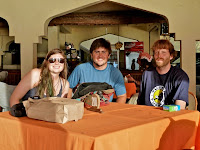Our safari guide company Pristine Tours, offers a complimentary coffee plantation tour when one purchases a safari. Needless to say, we jumped at the opportunity to get a closer look into the inner workings of one of the largest coffee exporting countries in the world. We travelled, off-road, to the steep slopes of Marangu, where endless amounts of coffee trees grow in the shade of towering banana trees.
When we arrived at the farm (which belonged to our guide Oscar) empty coffee mugs awaited us tempting us to participate in the long process that would eventually fill our cups with something deliciously fresh.
Oscar lead us to one of his coffee trees and picked a few berries, ranging in color from green to red. He explained the red means that the berry is ripe where as green does not. He also explained that the coffee bean has 3 shells or skins.
He explained that to test ripeness the first shell, when red, should have a very sweet taste. Nate was more than happy to participate in Oscars taste test. When harvested in bulk the berries are fed into a rotating grinder which cracks the shells and sorts the seeds.
The second shell of the coffee bean is then revealed. Because the bean is still wet from the berry skin the seeds are left to soak in water for 2 days.
After being dried in the sun the beans and their leftover shells are ready for the next stage.
The dried beans are poured into large mortar and pestle. The next part is quiet a bit of work as one person grinds the beans to crack the second shell the others in the group clap and sing a local Chagga song. “Twanga, Twanga Marc twanga, twanga mara moja, mbili tatu nne, tano sita saba, nane tisa kumi"
All the singing and grinding caught the attention of Oscars nephew.
Eager to join in, Oscar grabbed another (slightly smaller) mortar and pestle and then it was the little ones turn. Twanga!
After a good workout, the shells were mostly cracked and the green beans finally revealed. Oscar was happy to show us that our work was not finished. He picked up a bean and let each of us inspect the paper thin and yet resistant third and last shell.
Disregarding the last shell for now, Oscar poured the beans into a large pot, and began to cook. He told us that the heat would make the last shell separate from the beans and we would be left with the final product.
After 25 minutes of cooking (and salivating due to the intoxicating aroma) the now dark roasted beans were poured out to cool off. Oscar then proceeded to grind a couple handfuls in yet another mortar and pestle as water boiled on the fire.
Ten minutes later we all sat down, enjoying the freshest cup of joe ever, after a lot of hard but rewarding work.



















































